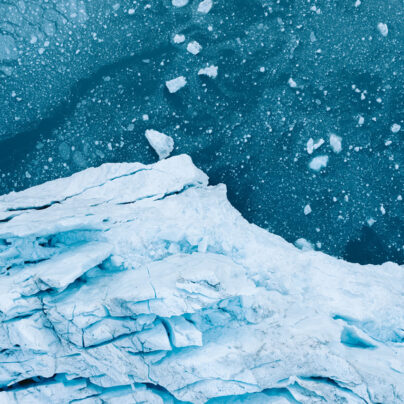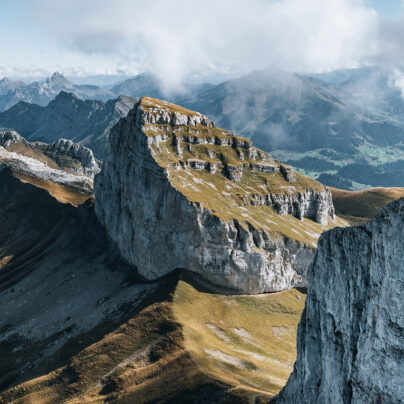Orizaba
Luc Mehl // Steve Fassbinder // Jim Harris
Photography by Jim Harris
In celebration of the launch of the brand new Sidetracked Volume Seven, we’re releasing one story online from each of our previous issues. In this story from Volume One, Luc, Jim, Steve and Todd travelled to Mexico City, bought cheap bikes, cycled 140 miles, climbed Orizaba – the tallest mountain in Mexico – and then packrafted 80 miles to the Gulf of Mexico.
JIM: With packrafts rolled in tight burritos and strapped to our handlebars, we roll into the rising sun. The very first pothole loosens the handlebars from the clasp of my bike’s stem and they begin to spin. With plans to give our rides away when we reach the headwaters of Rio Antigua, we’d sought cheap ones, hoping our mechanical know-how would help us nurse them through the coming days of hard riding. We buy a properly sized bolt for my stem, and then replace Fassbinder’s too. One of Fassbinder’s crank arms doesn’t tighten to its bottom bracket. My rear tyre blisters, then explodes a few miles later. We pull over often to realign shoddy parts and tighten bolts on our overloaded bikes. This is going to be some trip…
LUC: Converging for the first time in Mexico City International Airport, Mehl, Tumolo and Fassbinder are easy to spot. Each is traveling light, wearing the only set of clothes they’ve brought. Their technical fabric pants and weathered trail running shoes stand out amid the sea of loafers and slacks. Biking through Mexico City would be the most dangerous so we take the bus direct to Puebla and load up the cheap bikes we bought there with heavy kit.
JIM: Squeezed between semi trucks and tall curbs, I swerve over the remains of a dog. The next one isn’t more than a dry pancake but I cringe as I roll over the matted fur. The lanes narrow and the shoulder shrinks. I pedal past a third, fourth, fifth and sixth dead dog. One that’s hit but not yet dead watches us pass and the grim vision spins in my head. The frequency of road kill dogs becomes our litmus for how dangerous this section of the route is. There’s no room for bikes in the slim lanes and we continue in the ditch, granny-gearing along sandy washes. When we turn onto a quieter route a dozen miles later, I’m relieved to find long intervals between both dead dogs and passing semi trucks.
Our route climbs gradually towards Pico de Orizaba. Its hazy triangle outline distills into a white pyramid as we crest the foothill town of Tlachichuca. The pavement ends more than 3,000m below the summit but the climb continues on a rutted road blanketed by a duff of powdery volcanic dust. Sweat-slick, we’re magnets for the billows of airborne ash that swirl from our feet as we push our bikes up the steep track.
STEVE: We push our bikes into the fading light trying to make the most of our slow-progress day. The road is steep, dusty, and sandy. Each tortuous step is accompanied by sweat pouring off our brows. As we push, our legs become weak and we stumble on stones and slip on the dust. Ready to flop down just about anywhere, we pull off into the woods and it’s here we meet the ‘young doctors party club’. Apparently they appreciate dirty, tired, bearded Alaskan mountain guides because we share the only beer they have left before we camp for the night – a welcome joy after the day’s toil. We sleep under the stars, heavily-laden bikes propped against trees with the road in sight. The pushing begins in earnest the next morning. From our camp at around 3,500m to the Piedra Grande Refugio at 4,260m, the gradient is perhaps as much as 15%. Below, we can see the villages we have biked through the previous days and it gives us a sense of how far we’ve come and how high we are. It’s gratifying when we reach the Refugio.
Our route climbs gradually towards Pico de Orizaba. Its hazy triangle outline distills into a white pyramid as we crest the foothill town of Tlachichuca. Sweat-slick, we’re magnets for the billows of airborne ash that swirl from our feet as we push our bikes up the steep track.

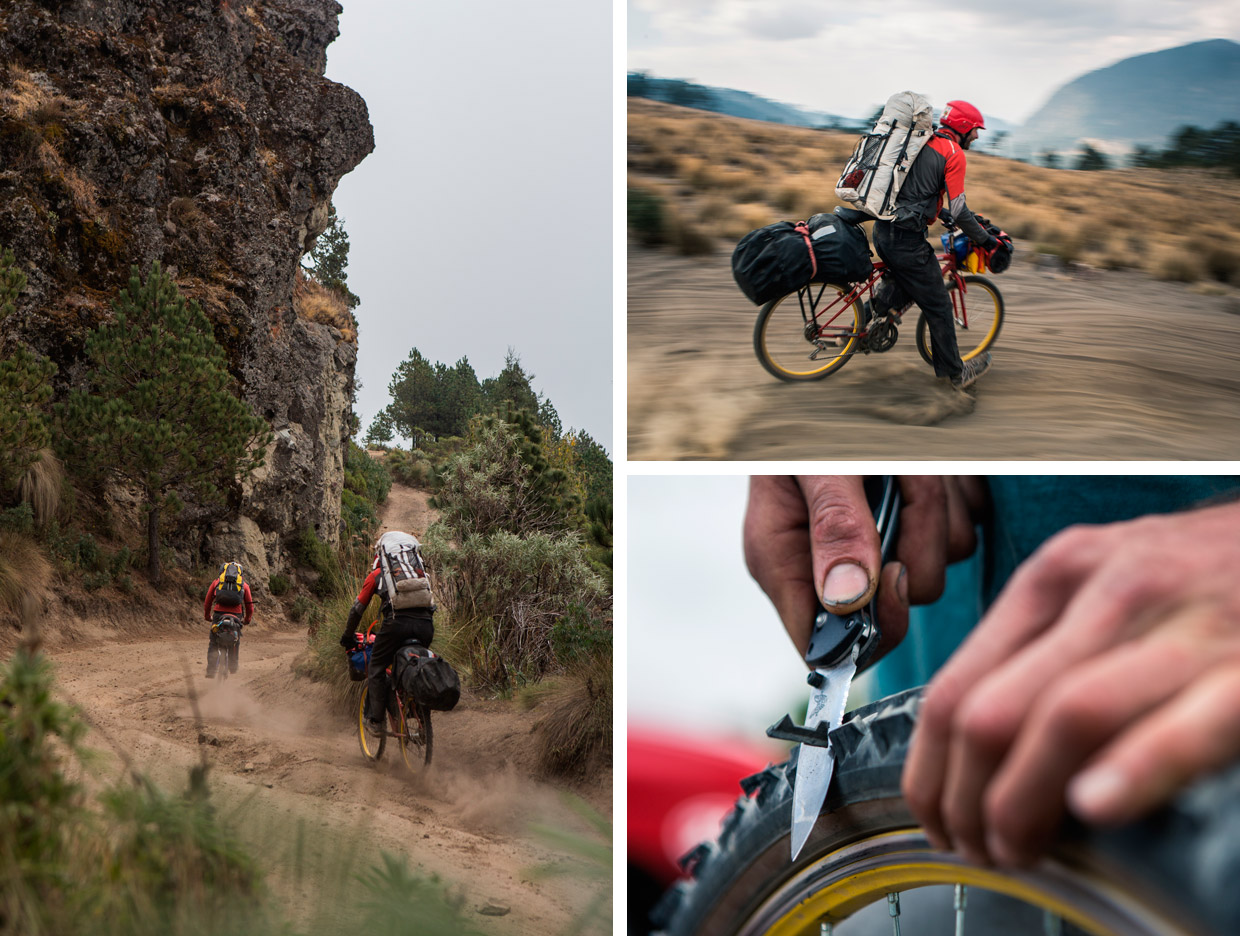

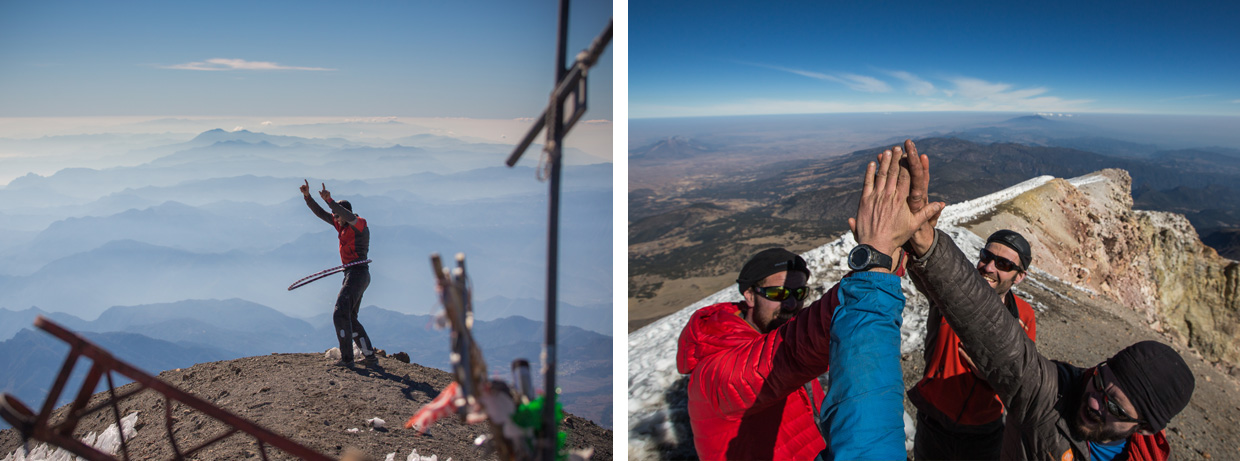
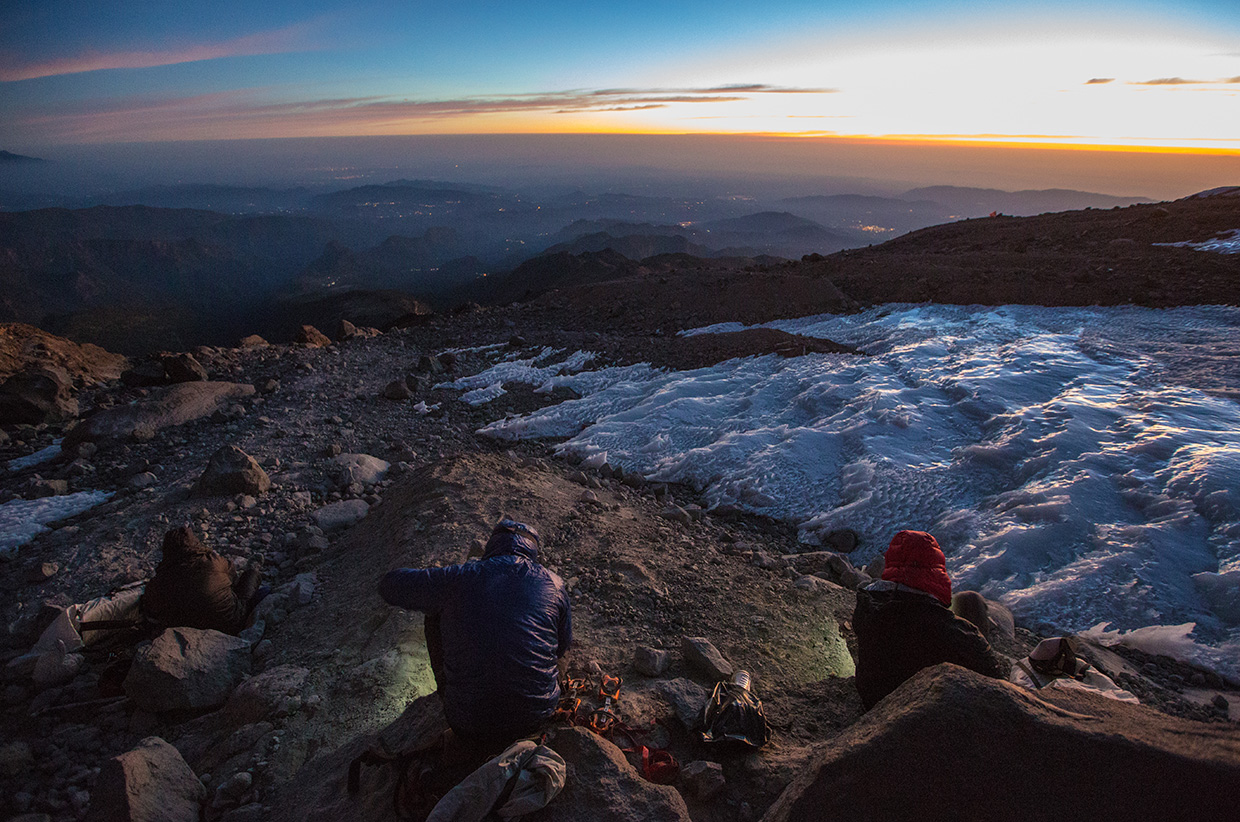
JIM: In the thin air at 4,260m, we lean against the cracked stonework of Pico de Orizaba’s Piedra Grande Refugio and unbuckle the ice axes that have rattled against our bike frames for the last 70 miles. From the hut, a trail leads upward through talus and worn slabs to the shrinking glacier that cups the upper slopes of Orizaba’s cone. Mehl, Tumolo and Fassbinder have fashioned insulated booties from used children’s jackets that fit over running shoes and under crampons. Their puffy smurf feet look like caricatures, but their toes stay warm. Reaching the top at 9am, we bask for an hour and a half in the high-watt sunshine and watch black little puffs of smoke sprout like mushrooms as trash piles are lit in villages thousands of metres below us. The view from the summit is striking, particularly the contrast between the arid campos to the west and the lush jungle canyons to the east.
We fly downhill, kicking up ‘rooster tails’ of dust. The first villages we pass are incredible; unlike anything we have seen on the west side. The children have faces as dirty as ours, and they flow to us like water from the fields and houses.
STEVE: The Refugio is thronging when we return, but we take full advantage of the captive audience by selling all of our ice axes, and one pair of slightly used crampons, at heavily discounted 4,000m prices. Then, the time comes for downhill.
LUC: We start the most incredible descent of our lives. We aren’t sure what to expect. I have selected a route based on poor satellite imagery, and we don’t know how steep the roads are, or if our bikes will hold up. But, the roads are great. We fly downhill, kicking up ‘rooster tails’ of dust. The first villages we pass are incredible; unlike anything we have seen on the west side. The children have faces as dirty as ours, and they flow to us like water from the fields and houses. We stop frequently to tighten bolts and replace brakes, but even so, we descend 3,800m that day. Todd, our least experienced biker, rides with reckless abandon; he clearly doesn’t understand how close the bikes are to catastrophic failure, and that a wreck at those speeds would mean broken equipment, or worse.
JIM: We are skidding around loose hairpins, and coasting through towns where the rubbish piles still smoulder. Our bikes rattle one degree less since selling or gifting our ice axes to local guides. Chickens patrol these streets and flocks of kids materialise from ditches, doorways, and alleys to chase our alien gringo bike gang. The summit’s lean atmosphere transitions to a misty, fragrant one where white rivers of vapour flow up from the rainforest below.
STEVE: I expect this ride to be in the upper echelon of massive historic downhills but my estimates are way off the mark. We leave the Refugio at about 2pm and proceed to lose over 2,500m of vertical height of Mexican back roads over the next five hours. It’s only due to darkness that we finally call it a day and camp in an inviting little cornfield on the edge of the biggest downhill ride I could ever imagine. Nearly 4,000m of descent in one day, whoa! We ask a farmer permission to camp in the rows of cornfield he’s working. Sure, he smiles. It’s not my field. The funny thing is that we wake up and immediately descend another 1,000m. This, of course comes with a price tag, as all good downhills do – brake-pads…
JIM: Rather than carry food, we buy it as we move, stopping for street tacos and eating produce right from the stand. One hungry night we buy two roast chickens and savage them on the spot despite our filthy hands. People stare. We’re a conspicuous group and there’s no part of our appearance, from gear-laden bicycles, to Fassbinder and Tumolo’s beards, to our roadside campsites, that helps us blend in. Every day, friendly and curious strangers wave us down to ask where we’re headed. ‘Vamos a la playa!’ becomes our slogan.
One last switchbacking descent leads to a bridge over the Rio Antigua where we plan to put in. 60 miles and 4,500m down from Orizaba’s summit, we’ve taken the bikes as far as we need them. Stripped of their loads, they creak less and feel almost nimble as we pedal into a pueblo pequeño just upstream. ‘Qué quiere esta bicicleta?’ I ask a man delivering a sack of coffee beans. Incredulous but elated, he shakes my hand between both of his then pedals off. Our bikes twirl through town under their new owners.
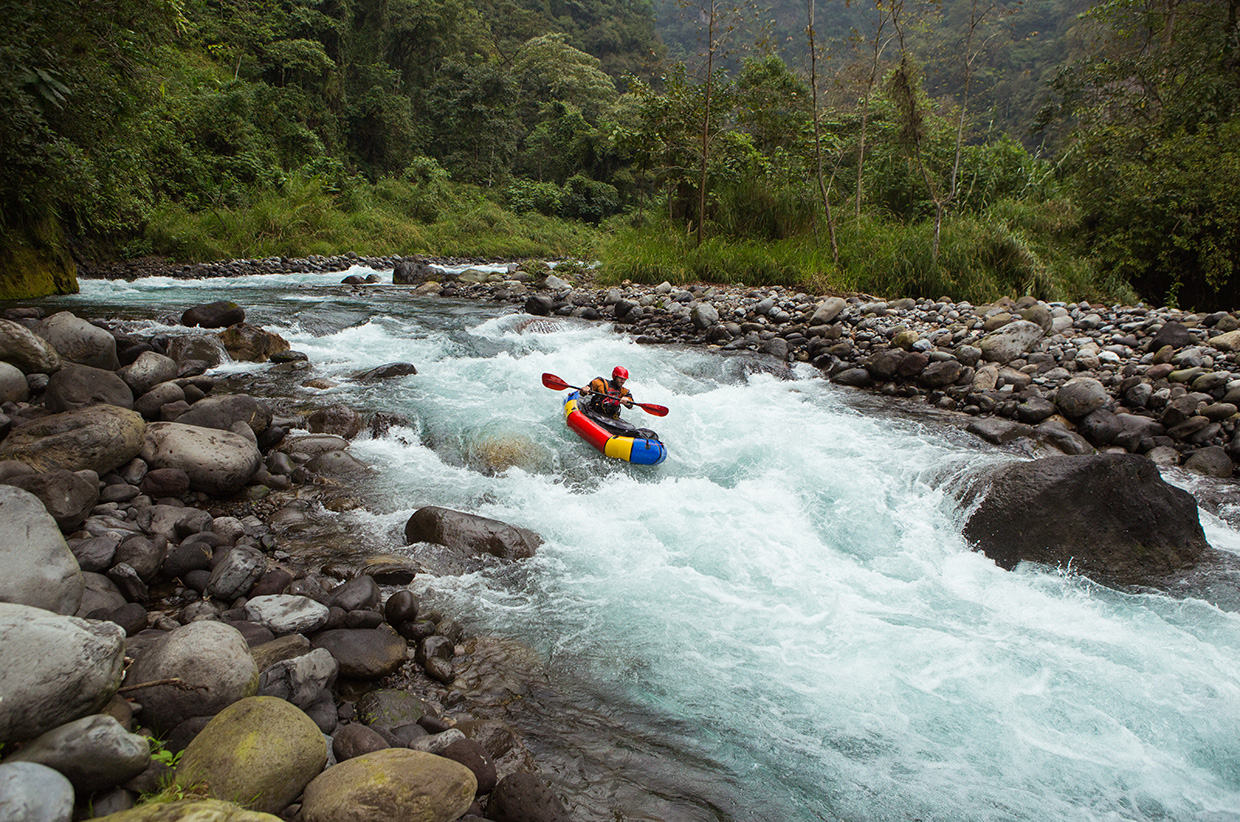


JIM: The final leg of Mehl’s traverse entails paddling inflatable Alpacka Raft boats 80 miles downriver to the Gulf of Mexico. The seven-pound boats are nimble, durable, and pack down to the size of a small two-person tent. In their latest incarnation, zippers in the boats’ sterns allow us to pack equipment inside before blowing them up. With camping gear stowed, the rafts have a low centre of gravity that will add stability and help us punch through the grabby rapids below.
LUC: We arrive at Rio Antigua, excited for the clear and clean water. We donate the bikes to locals and buy a few critical supplies: beer and bath soap. The beer is just beer, but the bath soap turns out to be laundry soap, which still removes the layer of dust and sweat from our bodies, but leaves us smelling a little too much likes roses.
The next morning we inflate our packrafts and start the 80 mile float to the ocean. The first day is spent in the stunning Barranca Grande. The canyon walls are lush with steep rock outcroppings and vultures, just specks against the blue sky, can be heard overhead. The rapids are not technical, but splashy enough to keep our attention. Oranges float in the water.
JIM: The Barranca Grande canyon contains few paths into the narrow jungle gorge and so the valley remains nearly uninhabited. Class III and IV rapids twist through the deep shade of the 350m deep corridor and we leapfrog downstream, drifting along overhanging walls shaggy with ferns. A little under 20 miles later, the pristine character of the river changes when the walls angle apart and tributaries carrying sewage and wastewater pour in. After each rapid, I spit river water from my compressed lips, hoping not to swallow much of it. I get involuntary sips anyway.
After our second day on the water, Mehl falls ill and spends the night retching in the bushes. The next night I take his place. Then Fassbinder. It’s impossible to pinpoint the source of our illnesses. Street meat? Unwashed produce? But the increasingly polluted river seems a probable culprit.
LUC: We begin to notice black ash falling from the sky. It takes a while to realise that the ash is from distant garbage fires. The fires and piles of garbage increase as we progress downstream. We grow to expect plastic bottles in every eddy and it is sad to see this pollution in what is otherwise a stunning landscape. Equally sad is that we are contributing to the problem – we drink bottled water the entire trip.
Seabirds, pelicans and herons, are welcome signs that we have reached our goal. The first sight of crashing waves is a thrill. We set our tents between piles of driftwood and prickly pear, and keep a fire burning late into the night. We reflect on our two-week journey through Mexico: the scenery, new friends, delicious food, a sunrise at 5,636m, happy chickens, dead dogs, rattled bikes. When it starts to rain, we move to the tents, tired, fulfilled, and not yet ready to acknowledge the departures and commitments waiting for us to the north.
JIM: Windmilling his kayak paddle into the breeze, Luc pulls onto the sandbar at the mouth of Mexico’s Rio Antigua and squints at the novelty of a seascape horizon in the hazy afternoon glare. Two days of sleepless dysentery have drained Mehl’s prodigious vigour and his hands are blanched and clammy as we high-five. Still, he’s grinning with accomplishment in the salt air. He watches, exhausted, while Steve and Todd and I enjoy the surf. It has been an emotional, draining but uplifting trip for all of us which is almost impossible to express in words. The people, the landscape and the experience – and doing it all in the way we have – makes us savour the achievement and the moment as something incredibly special.
This story was originally featured in Sidetracked Volume One
Written Luc Mehl, Steve Fassbinder and Jim Harris.
Photography by Jim Harris.
Website: thingstolucat.com
Instagram: @perpetualweekend


